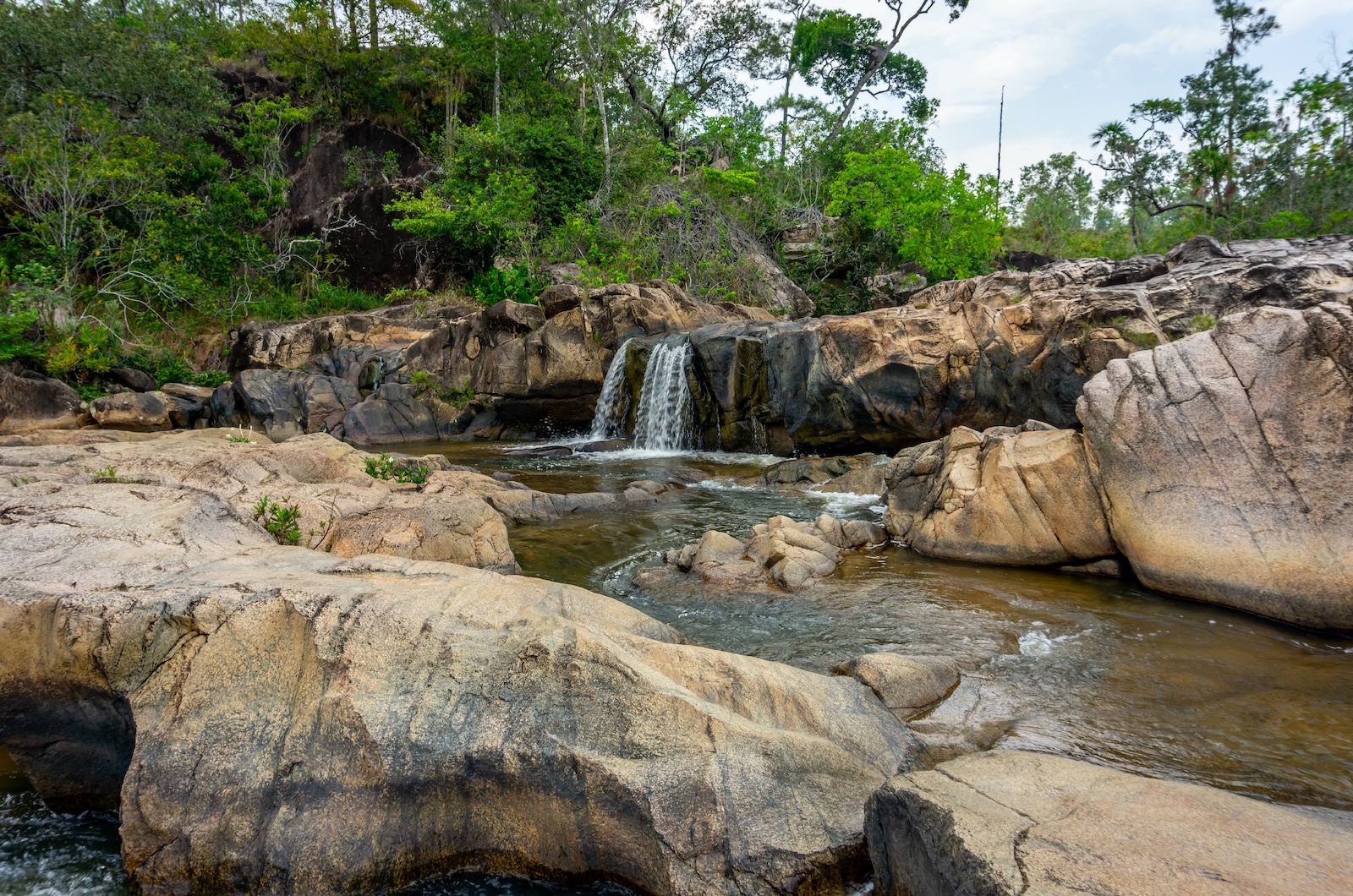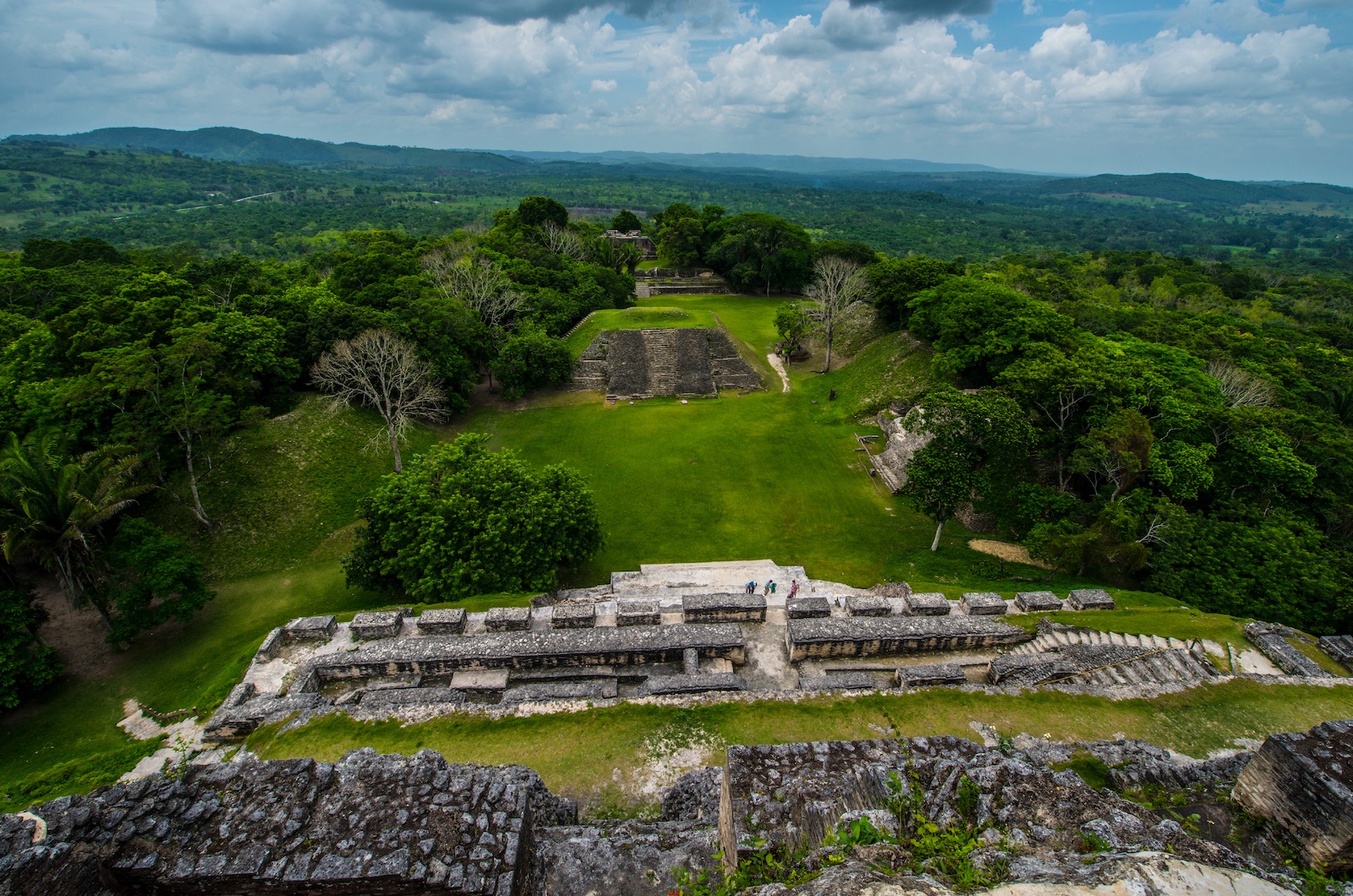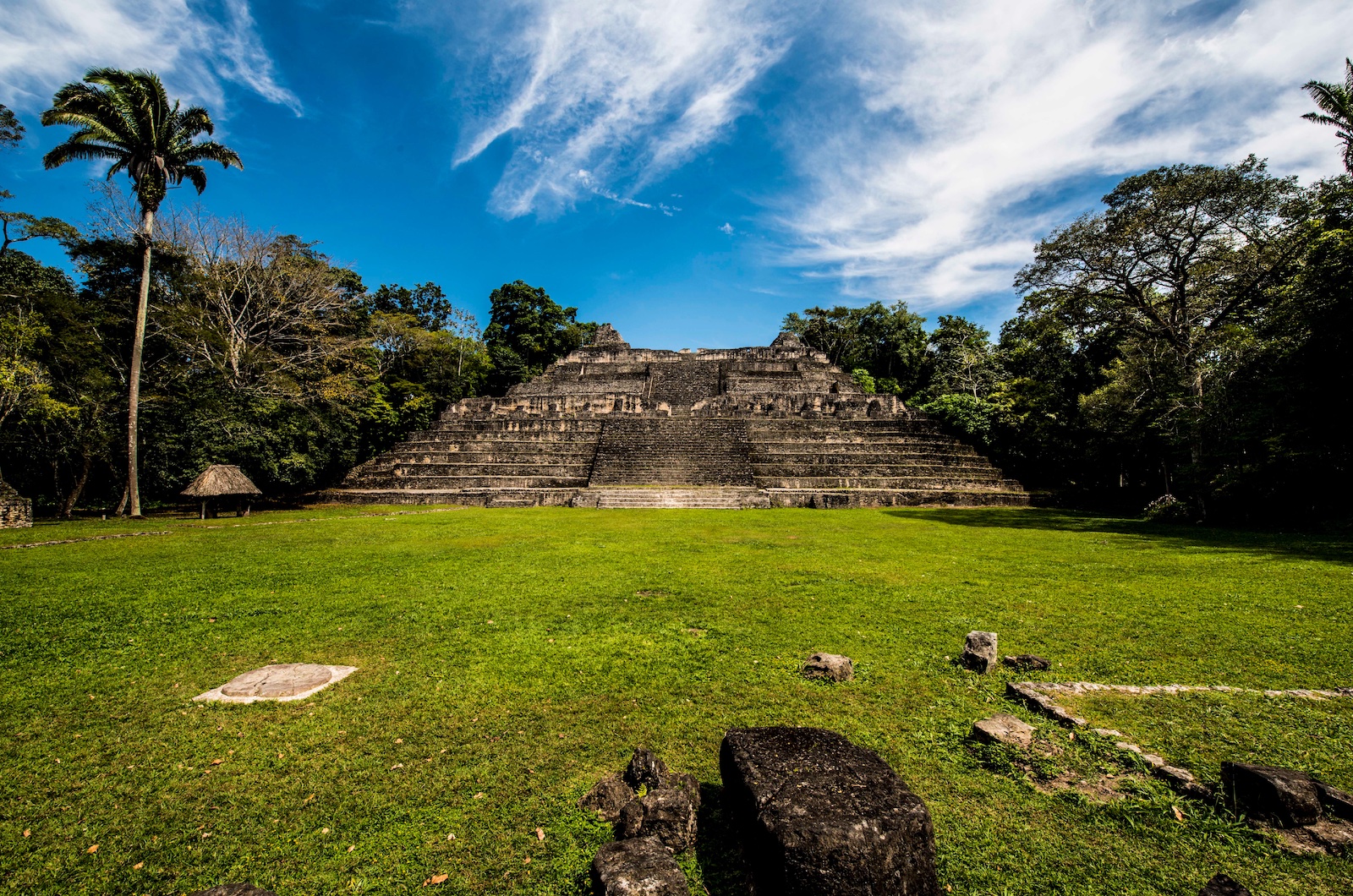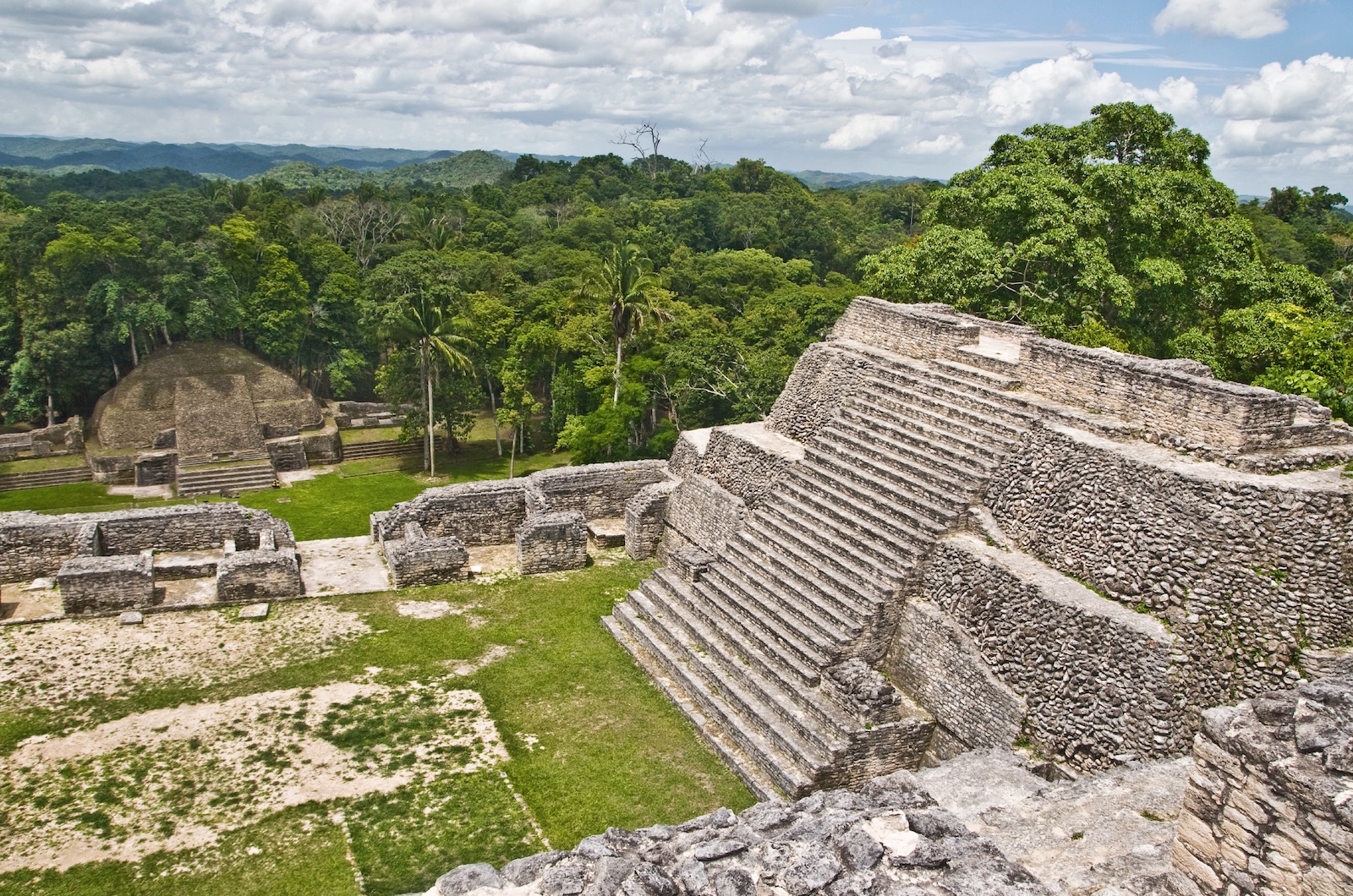The noise is deafening. A constant trilling, almost electric in its buzz, envelops us. Goodness knows how many small cicadas it takes to make this much noise, but amazingly, as the day gets hotter, their personal boom boxes will turn up the volume another notch or two.
It’s midmorning at Caracol, an ancient Maya city deep in the jungle of Belize, near the border of Guatemala. It may be the largest archeological site in this small country, but we have the place practically to ourselves.

River water flows over rocks into Rio On Pools in Belize’s Mountain Pine Ridge Forest Reserve. Photo by Medhi/Adobe Stock.
We set out early from Mystic River Resort, a Canadian-owned eco-lodge perched high on a bank above the Macal River, where we breakfasted while watching collared aracari (small toucans) peck at papaya and bananas put out to tempt them into view. Our guide, Abias, points out his village en route—San Antonio—with its crops of corn, papaya, and peanuts, and where his family still farms.
The terrain changes dramatically as we enter the Mountain Pine Ridge Forest Reserve and sign in at the checkpoint. Rangers are employed to protect the flora and fauna—orchids, white-tailed deer, wild turkeys and pigs—from hunters. Situated on a granite massif, the forest and its caves and ravines provide hideouts for jaguars and mountain lions. We spot the turnoff for Blancaneaux Lodge, the luxury resort owned by American film director Francis Ford Coppola, and shortly afterward, a sign for Rio On Pools, where we are promised a dip to wash off the dust of the day on our return. Soon after, road conditions turn truly rustic, and we bump slowly along for the remainder of the drive.
With habitation believed to have begun around 900 BC, Caracol came to attention in the modern era in 1937, when a local mahogany logger, Rosa Mai, stumbled upon it. The following year, A. Hamilton Anderson (archeology commissioner of the country, then called British Honduras) visited the site, but no excavations took place until the 1950s, work that continues today. Caracol is the Spanish word for snail, and Anderson named the place after finding large quantities of discarded shells from a freshwater variety, a staple of the Maya diet.
What has so far been uncovered is a tiny fraction of the original settlement. Archeologists estimate that Caracol at its peak was home to more than 100,000 citizens, nearly double that of Belize City today. Caracol’s population radiated out from its core to villages, and farmland beyond, spanning up to 200 square kilometres. Evidence of city planning, including a road system connecting urban and rural areas, has been uncovered. Jewels and other found objects indicate that the Maya were impressive traders with other cities near and far.
It’s hard to believe this was once the centre of a teeming metropolis, let alone comprehend the effort involved in its construction.
We walk past several smaller structures, including one used for astronomical observation, and marvel at a large colony of precariously hanging nests, home to the fabulous Montezuma oropendola, before we arrive at a marked-out area—the ball court. Here, the Maya played the game pok-a-tok, in which a solid rubber ball (weighing up to four kilograms) was hit back and forth using only the hip, knee, or elbow. On certain occasions, Abias tells us, this ritual game had very high stakes: “The loser was taken to a cave and sacrificed to the gods.”
Returning to the now grassy (and empty) plaza, I look up at the impressive main structure, Caana. It’s hard to believe this was once the centre of a teeming metropolis, let alone comprehend the effort involved in its construction. Standing 43 metres tall, Caana (“sky palace”) remains the highest structure in Belize.

Photo courtesy of Travel Belize.
It was built in phases, with successive rulers contributing. “It’s a solid structure,” Abias explains. “The Maya would construct one building, then build another one over it.” How they managed this is a matter of speculation, although the significant dates and happenings documented by the Maya in carvings, he says, show that population booms after successful wars coincided with construction periods, suggesting prisoners of war may have done the heavy lifting.
We begin the climb up Caana’s many tall stairs, some of which are replicas added during excavation to replace crumbled and dangerous stones. (Around the site, several replica carvings and objects stand in for those removed, either for local preservation or as part of the long tradition of archeological trophy hunting.)
I don’t need the cicadas to tell me it’s getting hotter as we make our way up to the royal residences at Caana’s apex, but it’s worth the sweat. Up here, at treetop level, the view across the dense jungle canopy is magnificent. Outside the small area cleared by archeologists, there is no hint of the scale of the civilization that once lived here. Yet, if you walk through the jungle, Abias says, you can still find evidence of the farming terraces the Maya employed.
“Most of the forest is considered secondary growth,” he explains. “The Maya had to clear thousands of trees to make space for their people and the farmland they needed to feed them.”
With hundreds of Maya communities slashing and burning as they rotated crops, one theory of their sudden demise, Abias says, is that it was due to a climate crisis they brought upon themselves. The rains, once plentiful, dried up in 880, the result, perhaps, of severe deforestation. Between 900 and 1000, Caracol was abandoned. Many years of drought caused desperation, the theory goes, with more and more sacrifices—increasingly children—made to appease the gods. Disaffection grew, and the starving population began to revolt.

Photo courtesy of Travel Belize.
“The royal buildings were set on fire,” Abias tells us. “Archeologists found the remains of a child lying on the ground, not buried in the royal tomb, and they believe that is a sign that the rulers left in a hurry. They were running.”
As we descend, carefully navigating the deep, narrow stairs, I try to imagine running down them in fear for my life. On cue, the buzzing of the cicadas is suddenly drowned out by a family of howler monkeys passing through the treetops nearby. Their screams are blood-curdling.
Read more from our Spring 2023 issue.









